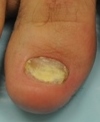 People with onychomycosis may experience significant psychosocial problems due to the appearance of the nail, particularly when fingers, which are always visible, rather than toenails are affected. Sufferers tend to avoid social and intimate situations until they find the right solutions. In Minnesota, we only have a short time frame to be able to wear sandals and it’s frustrating when you can’t get a pedicure or wear sandals due to a toenail fungus.
People with onychomycosis may experience significant psychosocial problems due to the appearance of the nail, particularly when fingers, which are always visible, rather than toenails are affected. Sufferers tend to avoid social and intimate situations until they find the right solutions. In Minnesota, we only have a short time frame to be able to wear sandals and it’s frustrating when you can’t get a pedicure or wear sandals due to a toenail fungus.
You are probably asking the question, what am I looking for? A nail fungus infection may begin as a white or yellow spot under the tip of your fingernail or toenail. As it spreads deeper into your nail, it may cause your nail to discolor, thicken and develop crumbling edges. It is usually not painful or other bodily symptoms, just unsightly, unless the disease is severe or develop ingrown toenail. Once a nail fungal infection begins, if not treated, it can persist indefinitely.
As the infection progresses the nail can become brittle, with pieces breaking off or coming away from the toe or finger completely. If left untreated, the skin can become inflamed and painful underneath and around the nail. There may also be white or yellow patches on the nail bed or scaly skin next to the nail.
Nail fungus symptoms may or may not include:
• Loss of luster and shine
• Thickening of the nail,
• Brittleness of the nail
• Change in nail shape,
• Crumbling of the outside edges of the nail
• Debris trapped under the nail
• Loosening or lifting up of the nail,
• White or yellow streaks on the side of the nail
• Loss of the toenail itself.



